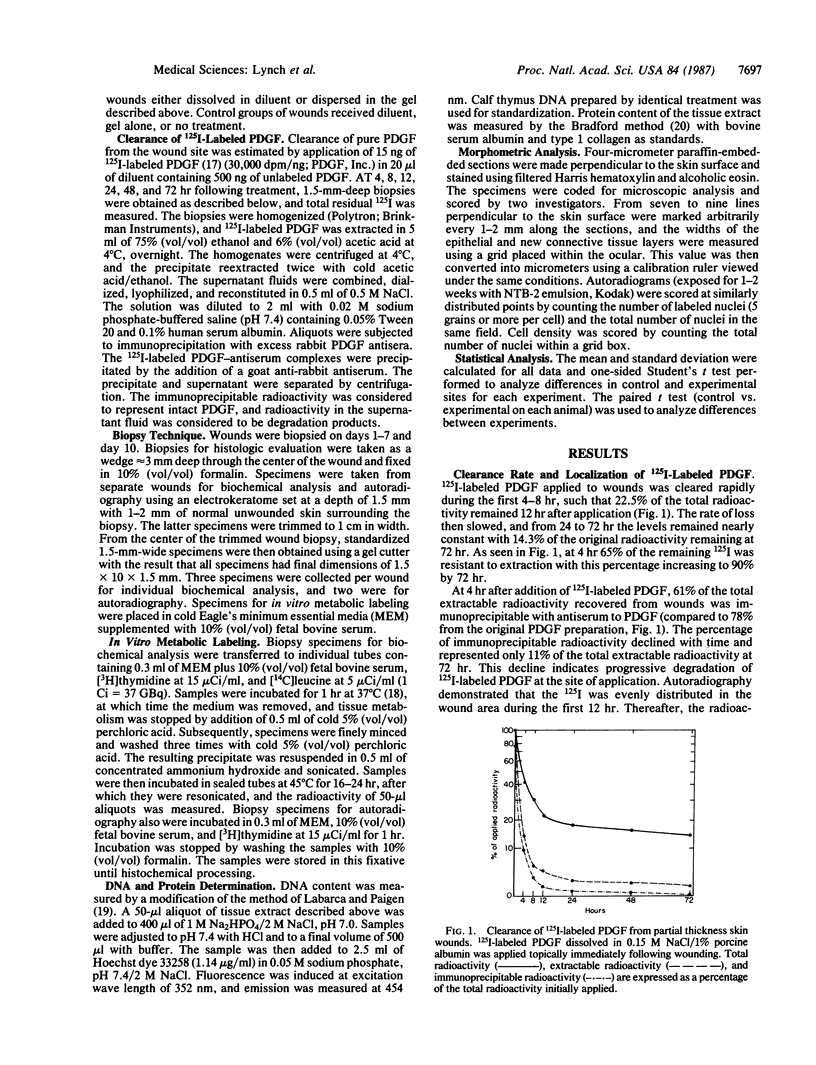Abstract
Platelet-derived growth factor (PDGF) in vitro stimulates DNA synthesis and chemotaxis of fibroblasts and smooth muscle cells and stimulates collagen, glycosaminoglycan, and collagenase production by fibroblasts. These in vitro properties suggest that PDGF, delivered by platelets to the site of injury in vivo, may play an important role in the initiation of the wound repair process. Studies presented here show that the addition of pure PDGF to a wound site involving the epidermis and dermis has little effect on the morphology or biochemistry of the healing wound. In contrast, the addition of partially purified PDGF resulted in significant dose-dependent increases in the width of the newly synthesized connective tissue and epidermal layers. Autoradiography using [3H]thymidine revealed increased numbers of labeled cells in the new connective tissue and epithelial layers. Furthermore, addition of partially purified PDGF resulted in significant increases in the rate of protein and DNA synthesis and the total content of these components in biopsies taken from the wound site. Similar effects were obtained when insulin-like growth factor I was added in combination with pure PDGF. This combination of factors caused a 2.4-fold increase in the width of the newly formed connective tissue layer and a 95% increase in epidermal thickness compared with controls. Insulin-like growth factor I alone caused no significant morphologic changes. Epidermal growth factor alone or in combination with PDGF resulted in a thickening only of the epidermis. These results indicate that the synergistic actions of other factors with PDGF are important in the modulation of the wound healing process.
Full text
PDF




Images in this article
Selected References
These references are in PubMed. This may not be the complete list of references from this article.
- Alvarez O. M., Mertz P. M., Eaglstein W. H. The effect of the proline analogue l-azetidine-2-carboxylic acid (LACA) on epidermal and dermal wound repair. Plast Reconstr Surg. 1982 Feb;69(2):284–289. doi: 10.1097/00006534-198202000-00018. [DOI] [PubMed] [Google Scholar]
- Antoniades H. N. Human platelet-derived growth factor (PDGF): purification of PDGF-I and PDGF-II and separation of their reduced subunits. Proc Natl Acad Sci U S A. 1981 Dec;78(12):7314–7317. doi: 10.1073/pnas.78.12.7314. [DOI] [PMC free article] [PubMed] [Google Scholar]
- Antoniades H. N., Scher C. D., Stiles C. D. Purification of human platelet-derived growth factor. Proc Natl Acad Sci U S A. 1979 Apr;76(4):1809–1813. doi: 10.1073/pnas.76.4.1809. [DOI] [PMC free article] [PubMed] [Google Scholar]
- Bradford M. M. A rapid and sensitive method for the quantitation of microgram quantities of protein utilizing the principle of protein-dye binding. Anal Biochem. 1976 May 7;72:248–254. doi: 10.1016/0003-2697(76)90527-3. [DOI] [PubMed] [Google Scholar]
- Buckley A., Davidson J. M., Kamerath C. D., Wolt T. B., Woodward S. C. Sustained release of epidermal growth factor accelerates wound repair. Proc Natl Acad Sci U S A. 1985 Nov;82(21):7340–7344. doi: 10.1073/pnas.82.21.7340. [DOI] [PMC free article] [PubMed] [Google Scholar]
- DiCorleto P. E., Bowen-Pope D. F. Cultured endothelial cells produce a platelet-derived growth factor-like protein. Proc Natl Acad Sci U S A. 1983 Apr;80(7):1919–1923. doi: 10.1073/pnas.80.7.1919. [DOI] [PMC free article] [PubMed] [Google Scholar]
- HUNTER W. M., GREENWOOD F. C. Preparation of iodine-131 labelled human growth hormone of high specific activity. Nature. 1962 May 5;194:495–496. doi: 10.1038/194495a0. [DOI] [PubMed] [Google Scholar]
- Labarca C., Paigen K. A simple, rapid, and sensitive DNA assay procedure. Anal Biochem. 1980 Mar 1;102(2):344–352. doi: 10.1016/0003-2697(80)90165-7. [DOI] [PubMed] [Google Scholar]
- Leitzel K., Cano C., Marks J. G., Jr, Lipton A. Growth factors and wound healing in the hamster. J Dermatol Surg Oncol. 1985 Jun;11(6):617–622. doi: 10.1111/j.1524-4725.1985.tb01906.x. [DOI] [PubMed] [Google Scholar]
- Roberts A. B., Sporn M. B., Assoian R. K., Smith J. M., Roche N. S., Wakefield L. M., Heine U. I., Liotta L. A., Falanga V., Kehrl J. H. Transforming growth factor type beta: rapid induction of fibrosis and angiogenesis in vivo and stimulation of collagen formation in vitro. Proc Natl Acad Sci U S A. 1986 Jun;83(12):4167–4171. doi: 10.1073/pnas.83.12.4167. [DOI] [PMC free article] [PubMed] [Google Scholar]
- Ross R., Raines E. W., Bowen-Pope D. F. The biology of platelet-derived growth factor. Cell. 1986 Jul 18;46(2):155–169. doi: 10.1016/0092-8674(86)90733-6. [DOI] [PubMed] [Google Scholar]
- Schultz G. S., White M., Mitchell R., Brown G., Lynch J., Twardzik D. R., Todaro G. J. Epithelial wound healing enhanced by transforming growth factor-alpha and vaccinia growth factor. Science. 1987 Jan 16;235(4786):350–352. doi: 10.1126/science.3492044. [DOI] [PubMed] [Google Scholar]
- Shimokado K., Raines E. W., Madtes D. K., Barrett T. B., Benditt E. P., Ross R. A significant part of macrophage-derived growth factor consists of at least two forms of PDGF. Cell. 1985 Nov;43(1):277–286. doi: 10.1016/0092-8674(85)90033-9. [DOI] [PubMed] [Google Scholar]
- Sporn M. B., Roberts A. B. Peptide growth factors and inflammation, tissue repair, and cancer. J Clin Invest. 1986 Aug;78(2):329–332. doi: 10.1172/JCI112580. [DOI] [PMC free article] [PubMed] [Google Scholar]
- Steel G. G., Bensted J. P. In vitro studies of cell proliferation in tumours. I. Critical appraisal of methods and theoretical considerations. Eur J Cancer. 1965 Nov;1(3):275–279. doi: 10.1016/0014-2964(65)90060-5. [DOI] [PubMed] [Google Scholar]
- Stiles C. D., Capone G. T., Scher C. D., Antoniades H. N., Van Wyk J. J., Pledger W. J. Dual control of cell growth by somatomedins and platelet-derived growth factor. Proc Natl Acad Sci U S A. 1979 Mar;76(3):1279–1283. doi: 10.1073/pnas.76.3.1279. [DOI] [PMC free article] [PubMed] [Google Scholar]




